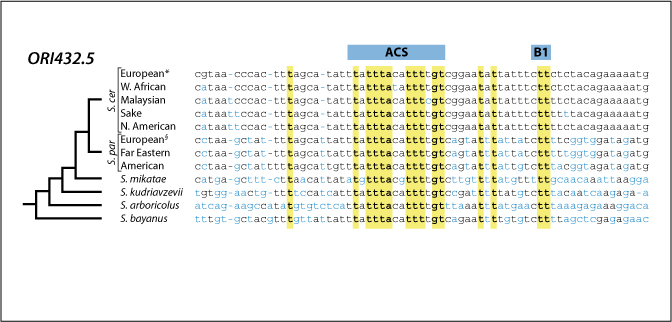The awesome power of comparative genomics
We have found that the patterns of genome replication are very similar in different yeast species (in evolutionary terms equivalent to comparing people with birds). At the majority of replication origins we found an evolutionary conserved sequence responsible for binding the replication proteins. This evolutionary conservation leaves a 'footprint' in the sequence helping us to identify the functional DNA sequence. In addition, we have found that the activity of the majority of origins is also conserved. However, in these comparisons, we were able to discover individual replication origins that show dramatic differences in activity between the yeast species. We are investigating what is responsible for this difference in origin activation time between the two species. Our experiments suggest that DNA 'regulatory' sequences close to the origin are responsible. Current experiments aim to find these sequences and determine how they alter the activation time of the replication origin.
Comparative genomics is a formidable tool for assigning function to DNA sequence — a pressing challenge in the age of high throughput sequencing technologies. We discovered that sequences essential for replication origin function are frequently conserved in sensu strict Saccharomyces species (Nieduszynski et al., 2006). These sites are protein bound (by the Origin Recognition Complex) and therefore the evolution of the sequence is restrained, resulting in a ‘phylogenetic footprint’. The sequence conservation allowed us to identify replication origin sequences throughout the Saccharomyces cerevisiae genome at base pair resolution.
We have compared the location and activity of replication origins in four sensu strict Saccharomyces species Saccharomyces cerevisiae, S. paradoxus, S. arboricolus, and S. bayanus (Müller & Nieduszynski, 2012). We discovered that the locations of active origins are predominantly conserved between species, whereas dormant origins are poorly conserved. Using deep sequencing we generated genome-wide replication profiles for each of these species and discovered that the temporal order of genome replication is highly conserved. Therefore, active origins are not only conserved in location, but also in activation time. Consequently the dynamics of genome replication are remarkably similar between species. Finally, we have discovered individual origins that are conserved in location but that differ in activity between species. These origins are particularly significant because they offer an opportunity to discover the mechanisms that regulate origin activity.
Related publications
Conservation of replication timing reveals global and local regulation of replication origin activity.
Müller & Nieduszynski (2012)
Genome Res., 22(10):1953-62
Comparative functional genomics of the fission yeasts.
Rhind et al. (2011)
Science, 332(6032):930-6
From sequence to function: Insights from natural variation in budding yeasts.
Nieduszynski & Liti (2011)
Biochim. Biophys. Acta, 1810(10):959-66
Genome-wide identification of replication origins in yeast by comparative genomics.
Nieduszynski et al. (2006)
Genes Dev., 20(14):1874-9

